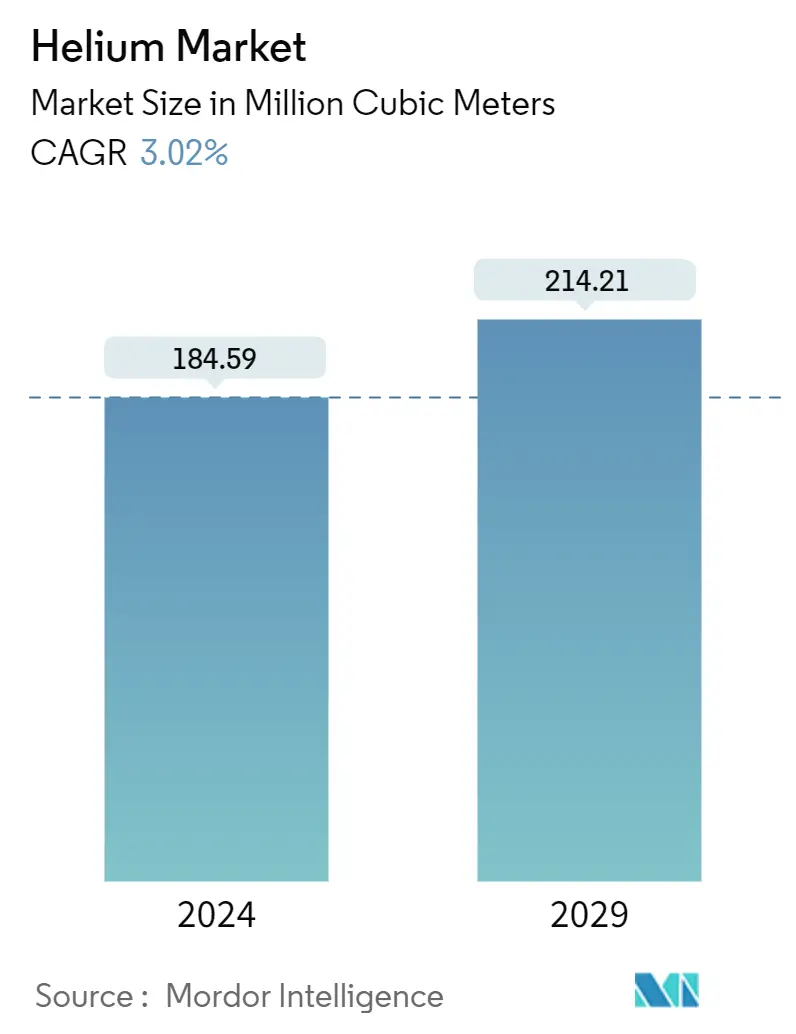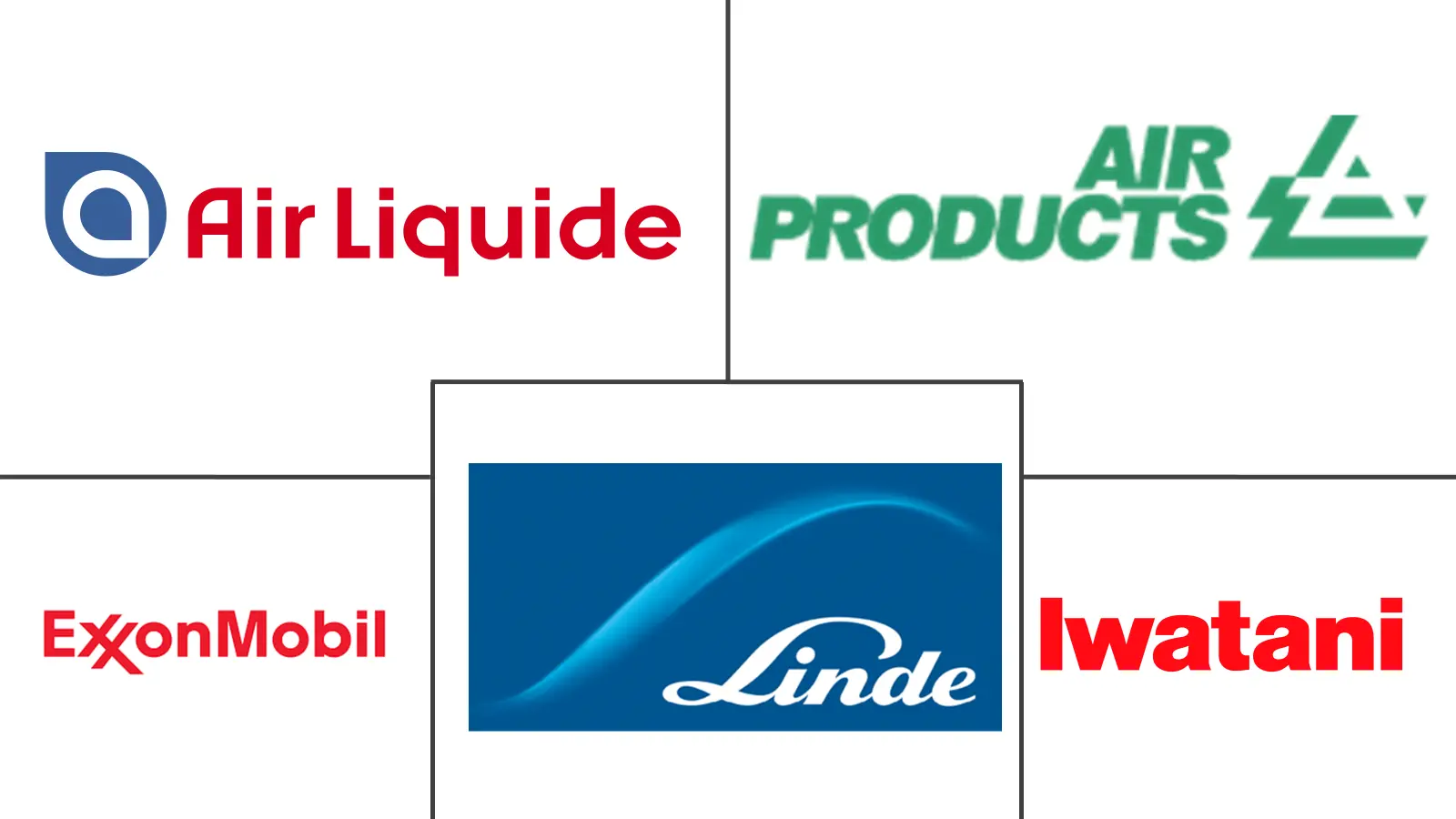
The helium market is projected to experience growth over the forecast period, driven by increased consumption in sectors such as semiconductors and aviation. Despite challenges like high extraction costs and inconsistent supply, opportunities are emerging from efforts to address helium shortages and its expanding use in pulmonary treatments. The market's expansion is influenced by the recovery of the aerospace industry and the rising demand in healthcare applications. Europe is anticipated to lead in market share, while the Asia-Pacific region is expected to grow at the fastest rate.
Download Free Sample Now Table of Contents Download SampleSingle User License
Book before: 

*Disclaimer: Major Players sorted in no particular order
Need a report that reflects how COVID-19 has impacted this market and its growth?
Download Free Sample
Single User License
Book before:The Helium Market size is estimated at 184.59 Million cubic meters in 2024, and is expected to reach 214.21 Million cubic meters by 2029, growing at a CAGR of 3.02% during the forecast period (2024-2029).
Due to COVID-19, the aerospace industry was severely affected, resulting in the contraction of the aerospace industry in recent times, negatively affecting the growth prospects of helium in aerospace applications. However, it recovered significantly in 2021, owing to rising consumption from various end-use applications, including healthcare.
Helium is a chemical element with the symbol He. It is a colorless, odorless, and tasteless gas and is the second lightest and most abundant element in the universe. It is a non-renewable resource, and its supply is limited. Helium has several important applications in cryogenics and superconductivity, balloons and airships, welding and leak detection, breathing mixtures, aerospace and rockets, nuclear energy research, etc.
The helium market is segmented by phase, application, end-user industry, and geography. By phase, the market is segmented into liquid and gas. By application, the market is segmented into breathing mixes, cryogenics, leak detection, pressurizing and purging, welding, controlled atmosphere, and other applications. By end-user industry, the market is segmented into aerospace and aircraft, electronics and semiconductors, nuclear power, healthcare, welding and metal fabrication, and other end-user industries. By geography, the market is segmented into Asia-Pacific, North America, Europe, and Rest of the World). The report also covers the market sizes and forecasts for the helium market in 14 countries across the major regions. For each segment, the market sizes and forecasts are provided based on volume (cubic feet).
| Phase |
| Liquid |
| Gas |
| Application |
| Breathing Mixes |
| Cryogenics |
| Leak Detection |
| Pressurizing and Purging |
| Welding |
| Controlled Atmosphere |
| Other Applications |
| End-user Industry |
| Aerospace and Aircraft |
| Electronics and Semiconductors |
| Nuclear Power |
| Healthcare |
| Welding and Metal Fabrication |
| Other End-user Industries |
| Production Analysis |
| United States |
| Qatar |
| Algeria |
| Australia |
| Poland |
| Russia |
| Other Countries |
| Asia-Pacific |
| China |
| India |
| Japan |
| South Korea |
| Australia and New Zealand |
| Rest of Asia-Pacific |
| North America |
| United States |
| Canada |
| Mexico |
| Europe |
| Germany |
| France |
| Italy |
| United Kingdom |
| Russia |
| Rest of Europe |
| Rest of the World |
| South America |
| Middle East and Africa |
The helium market is poised for steady growth over the forecast period, driven by increasing demand across various industries such as healthcare, semiconductor, and aviation. The market's expansion is supported by the recovery of the aerospace sector post-COVID-19 and the rising consumption of helium in healthcare applications, particularly for MRI machines and respiratory treatments. However, challenges such as high extraction costs and inconsistent supply may impede growth. Despite these hurdles, advancements aimed at addressing helium shortages and the growing adoption of helium in medical treatments present significant opportunities for market players. Europe is anticipated to lead the market, with Asia-Pacific expected to experience the highest growth rate, fueled by robust healthcare sector developments.
In the healthcare industry, helium's unique properties make it indispensable, especially in cryogenic applications and respiratory care. The increasing demand for MRI scans and the rising prevalence of respiratory conditions are key factors driving helium consumption in this sector. North America, particularly the United States and Canada, dominates the healthcare helium market due to substantial healthcare expenditure. Meanwhile, Europe benefits from its strong medical equipment manufacturing base, with Germany playing a pivotal role in the semiconductor and medical device markets. The region's aerospace industry also contributes to helium demand, with France being a significant player. The market is characterized by consolidation, with major companies like Air Liquide and Linde PLC leading the industry, actively engaging in strategic agreements and investments to enhance their helium supply capabilities.
The Helium Market size is expected to reach 6.51 billion Cubic Feet in 2024 and grow at a CAGR of 3.02% to reach 7.56 billion Cubic Feet by 2029.
In 2024, the Helium Market size is expected to reach 6.51 billion Cubic Feet.